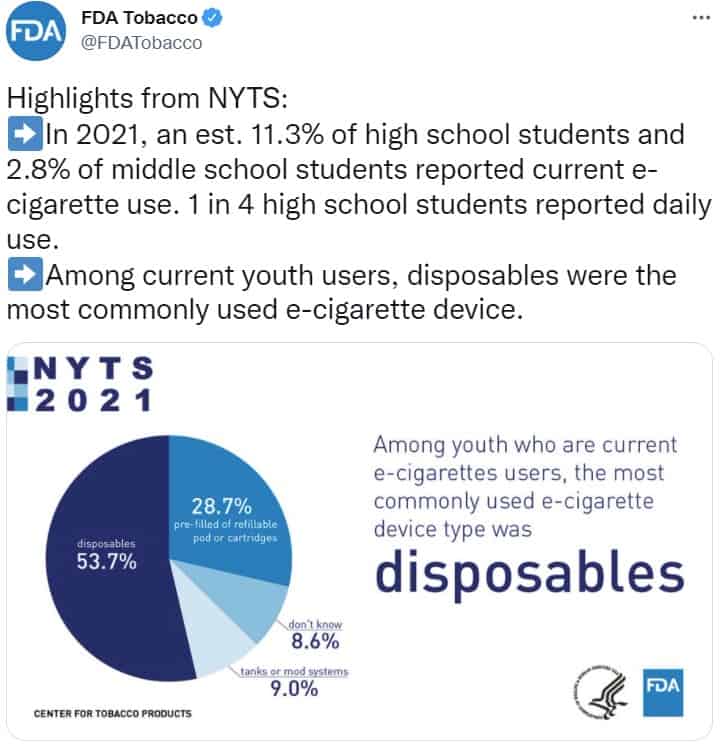The Youth Vaping “Epidemic” Has Ended; So Should Extreme Youth-Centric Anti-Vaping Measures

Photo Credit: Getty
People will tolerate just about any imposition if they believe it will protect children from harm. Hence, appeals to “think of the children” are often invoked in politics. But nowhere has this sort of emotional manipulation been as blatant as with the issue of e-cigarettes. It is no accident that the debate over vaping has become singularly fixated on the issue of youth vaping. That is the intended result of a well-funded political campaign aimed at dragging the conversation away from the science, which shows e-cigarettes are a life-saving alternative to combustible tobacco, and instead transforming the issue into a false moral choice between saving adults or protecting children. So far, that prohibitionist narrative has worked.
Based on the belief that youth vaping is both widespread and dangerous, governments around the world have adopted radical anti-vaping policies, including total prohibitions, as extreme but supposedly necessary measures. But new evidence released by the U.S. government provides further evidence that the “epidemic” of youth vaping, if it ever existed at all, is over. Therefore, there is a compelling argument that, when it comes to questions about how e-cigarettes should be regulated (or even banned), we should stop thinking solely about youth and more about the millions of current and future adults whose lives these products might save.
According to the latest National Youth Tobacco Survey results, youth vaping has declined a whopping 60 percent in the last two years, with just 11.3 percent of high schoolers reporting any e-cigarette use in the past month. That puts the 2021 rate of youth vaping lower than it was in 2014 and about half the level it was in 2018—the year that then-Food and Drug Administration (FDA) Commissioner Scott Gottlieb declared youth vaping an “epidemic.”

This good news has been grossly underreported and, where it has been reported, it has been spun to promote the idea that youth vaping remains the most important aspect of the e-cigarette policy debate. Again, that is no accident, but the product of a coordinated effort by anti-vaping activists and their allies to dismiss the latest national survey findings as little more than an artifact of the pandemic.
To some degree, skepticism about the survey is justified. Unlike in previous years, the 2021 data were collected online with schools closed due to COVID-19. Lockdowns also limited teenagers’ opportunities to socialize, which also likely affected the results, since most youth who report vaping are “experimenters,” taking a hit off a friend’s vape once or twice rather than being habitual users who own their own device. All that said, there are several reasons the results and the declining trend in youth vaping should not be ignored.
First, the decrease in youth vaping began in 2019, before COVID lockdowns. And while critics might still claim that two years of data showing declines in youth vaping is not enough to qualify as a “trend,” such limited data were enough to label youth vaping an “epidemic” when the trend was upward.
Second, and perhaps more telling, is the fact that during lockdowns youth drinking and cannabis use did not decline, indicating that if youth had wanted to vape, they would have, regardless of lockdowns, but they didn’t.
Instead of celebrating the results with cautious optimism and trying to figure out what led to youths’ declining interest in e-cigarettes over the last two years (perhaps something to do with reduced media attention), anti-vaping advocates and their allies have gone into overdrive to spin the data to sound as scary as possible, lest anyone think the youth vaping “epidemic” is over.
Take, for example, the FDA’s press release announcing the survey results, which featured the headline, “Youth E-cigarette Use Remains Serious Public Health Concern Amid COVID-19 Pandemic.”
Similarly, the FDA’s Center for Tobacco Products (CTP) issued a series of tweets that did not even mention the fact that youth vaping has declined. Instead, CTP focused on the unreliability of this year’s survey, while citing its results as cause for continued concern. Anti-vaping advocates have seized on these talking points, no matter how misleading, to promote their agenda.

One survey result that has received attention is that one in four high school students said they used e-cigarettes every day. That might seem confusing, given that only 11.3 percent of high schoolers reported vaping at all in the last month, but confusing the public is the point. What the survey actually found was that 26.7 percent of the high school students who reported any vaping in the last month reported vaping daily. Or, put in numbers that make sense, 3 percent of high school students—but 3 percent isn’t exactly panic-inducing. So, while presenting a percentage of a percentage may be technically accurate, it seems intended to make youth vaping seem like a bigger problem than it actually is.
Also highlighted by the FDA is the survey’s finding that among youth who vape, over 80 percent said they used “flavored” e-cigarettes (those flavored like something other than tobacco.) Again, this is communicated as a percentage of a percentage because it sounds scarier than saying 9 percent of high school students used flavored e-cigarettes, as the survey found.
Furthermore, one might wonder why youth use of “flavored” e-cigarettes matters, given that the evidence doesn’t show them to be more harmful, habit-forming, or likely to lead to smoking than tobacco-flavored e-cigarettes. The answer is, it doesn’t matter. At least, it doesn’t matter for public health, but it matters a great deal to anti-vaping crusaders, including some members of Congress who have made banning flavored e-cigarettes a top policy goal.
Of course, we should think about children and their long-term wellness. But we cannot think only about that one segment of the public. That is especially true for policy makers who, if they hope to truly maximize benefits and minimize harm, need to consider the effects of products and policies—good and bad—for all groups, not just youth. That said, if one group should be prioritized by policies aimed at reducing the burden of tobacco-related illness, there is a compelling argument that the focus should be on older adults, not children.
The prevalence of smoking in the U.S. is lower than it has ever been, thanks in no small part to anti-tobacco activists’ efforts to educate the public on the dangers of smoking. Yet, not everyone appears to have benefited from that decline. Smoking remains high among a number of already disadvantaged groups, including older Americans, who smoke at nearly twice the rate of those under 25. And, while the good news is that smokers who quit before middle age virtually eliminate all of the long-term risks, the bad news is that successfully quitting—or even trying to quit at all—becomes harder and less likely the older one gets. It is this group, the heavy smokers in their 30s, 40s, and 50s, who are at the greatest risk for smoking-related illnesses and the most likely to benefit from access to satisfying, lower-risk alternatives to smoking, like e-cigarettes.
Looking beyond the spin to the actual numbers and their context, the youth vaping issue doesn’t seem so worrisome. Like previous editions of the national survey, this year’s results confirm that the 89 percent of high school students don’t vape at all, most who do vape infrequently, and the majority of frequent vapers were previously smokers.
Moreover, the rate of youth experimentation with nicotine e-cigarettes, even before the recent declines, is similar to that for other risk-taking behaviors, like cannabis use and binge drinking. Like cannabis use, the risks posed to youth by nicotine vaping, though perhaps not negligible, are small and—apart from concerns about dependence—entirely theoretical and a fraction of the risks posed by smoking (which many of the youth who vape would be doing in the absence of e-cigarettes).
None of this is to say that youth vaping should be ignored and we can expect anti-vaping activists to persist in beating that particular drum. But, as the latest survey data make clear, we also cannot continue to ignore adults. If saving lives and improving public health is truly the goal, policies must be carefully crafted to balance risks against benefits for all segments of the population. Such balance will never be achieved unless policymakers stop thinking so much about the children and more about the 34 million American adults who continue to smoke and whose lives could be saved by switching to noncombustible sources of nicotine, like vaping.